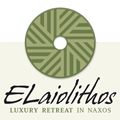HANDMADE JEWELS: Experience the Tradition of the Art of the Loom Weaving in Naxos…. Cotton artifacts made of original, environmentally friendly, Greek cotton…
An art that romanticizes the handmade….
Travel Moments to Inspire…….Discover local eco-arts and crafts on your holiday travel..… Hand-woven, beautiful, artful and sustainable…..
Simplicity and responsible consumption, especially in textiles, always has been fascinating to me. One of the first objects we came in contact with when we were born was a blanket or gauze that we were wrapped in – all hand made by our mother…..When I think about hand-woven textiles I think about source and resource. I think about sustainability. What role can I play and what you – as a traveler of the world – can do. The loom weaving tradition shows care for our environment and natural resources and maintains the integrity of our biodiversity and ecosystem.
ELaiolithos supports and promotes cultural curiosity and a sense of discovery by offering a sophisticated tour on handmade artisan crafts to the audience seeking authentic, responsibly sourced local crafts with high aesthetics. The fascinating reality of this local tradition is dating back to antiquity…Hand-loom weaving in Naxos would instantly take you with its exotic charm and high aesthetics.
A loom is a device used to weave cloth and tapestry. The basic purpose of any loom is to hold the warp threads under tension to facilitate the interweaving of the weft threads. The precise shape of the loom and its mechanics may vary, but the basic function is the same. Loom weaving is among the most sophisticated and time consuming jobs in the world.
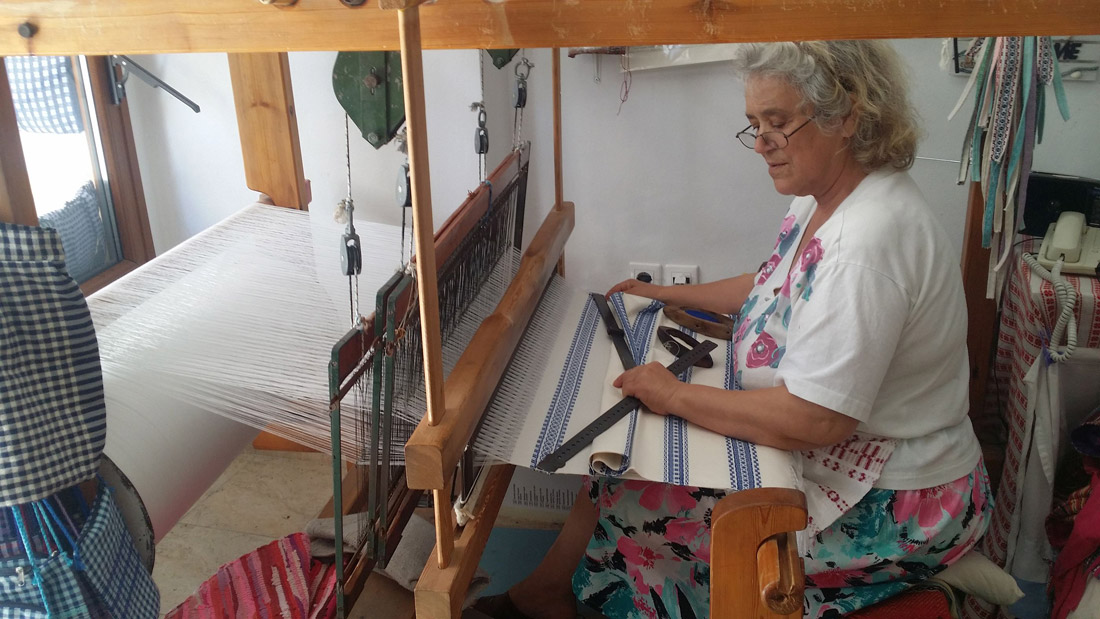
Naxos is among the remaining islands of Greece that has a significant tradition in textile weaving and still produces organic textiles coming from the genius of its master women weavers. The world has lost the hand-weaving and loom process, along with all natural and organic processes of creating textiles. One place in Greece and specifically in Cyclades is Naxos island, that still keeps this tradition alive with the women of Moni village to play the first role now days in this artistic handmade production of the loom weaving artifacts.
The striking thing about an island as big as Naxos is the sheer, overwhelming variety that it encompasses – of landscapes, tradition, language, cuisine, Natura and natural heritage sites. Naxos is a very diverse land, full of surprises. One of the most unique experiences and a must-see for anyone visiting Naxos is a visit to a Workshop-Exhibition of the hand loom weaving – a tradition that is still alive to present day and it is of extraordinary beauty, quality and technique expertise. All of the textiles are handwoven and hand-embroidered and reflect the highest standard in artisan excellence. The structure of the weave and the visual appearance of the fibers collectively reflect the superior quality of these textiles. Each textile features individual yarns and varying patterns woven with intricate cohesion.
The origin of weaving goes back to the dawn of civilization to at least 8000 years ago. Weaving began about 5000 BC with flax. Spinning was developed first with weaving later. Weaving was an important tradition for women in ancient Greece and it is still an alive tradition in many parts of Greece with Naxos to be among the active ones in current days. In the Naxian culture, weaving textiles with the loom is considered a craft creation, an art, a commodity, a form of self-expression, and a symbol of life and tradition itself. It is a complex and difficult art that tends to disappear in most villages, but the women of Moni village continue this tradition to nowdays.
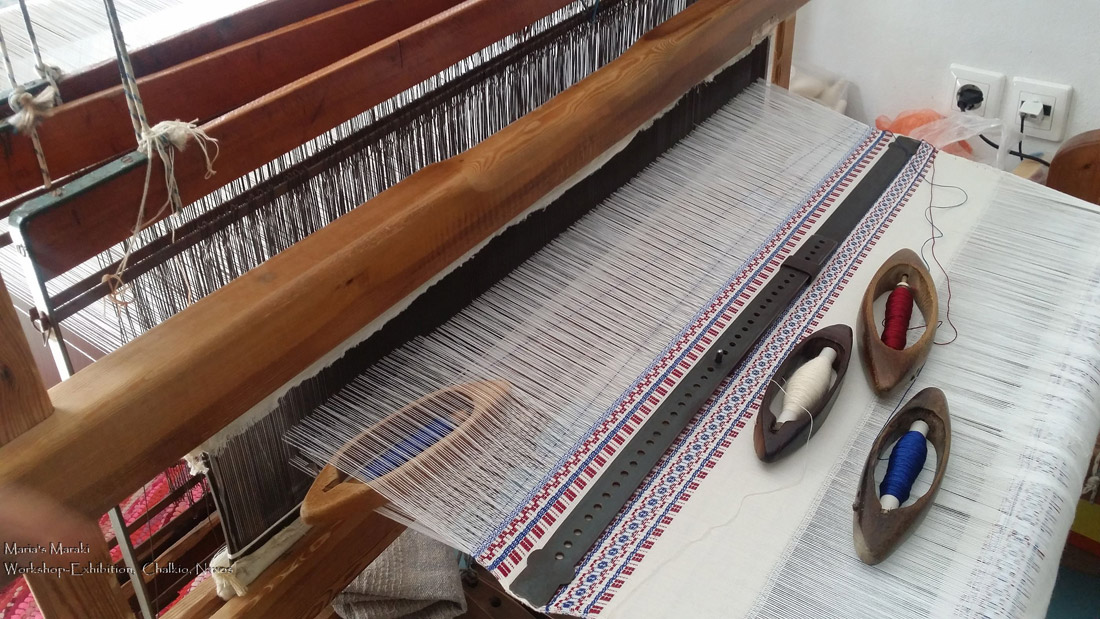
In Greece the Moirae (the “Fates”) are the three crones who control destiny, and the matter of it is the art of spinning the thread of life on the distaff. Ariadne, the wife of the god Dionysus, possessed the spun thread that led Theseus to the center of the labyrinth and safely out again. Helen is at her loom in the Iliad to illustrate her discipline, work ethic, and attention to detail. Homer dwells upon the supernatural quality of the weaving in the robes of goddesses where a composition of patterned stripes, figured bands, ornamented borders, and plain fabrics are seen.
The loom is a machine that is 100% hand curved by a local skillful wood craftsman. There are looms of many sizes, types, and degrees of complexity. Most looms are like operated with treadles or levers. Weaving with a loom is pure art. Weaving is an extremely long repetitive process which requires a great deal of patience, and focused attention, it is creative, and it is very rewarding at the end when the creations are completed. When you weave, you bring together different yarns and fabrics and unify them in a single, unique artifact. You can make clothes, accessories, and home decor in cotton fibers from plain to fancy and elaborate. The raw material used is pure Greek cotton and also silk – all are entirely natural products and come primarily from northern Greece.
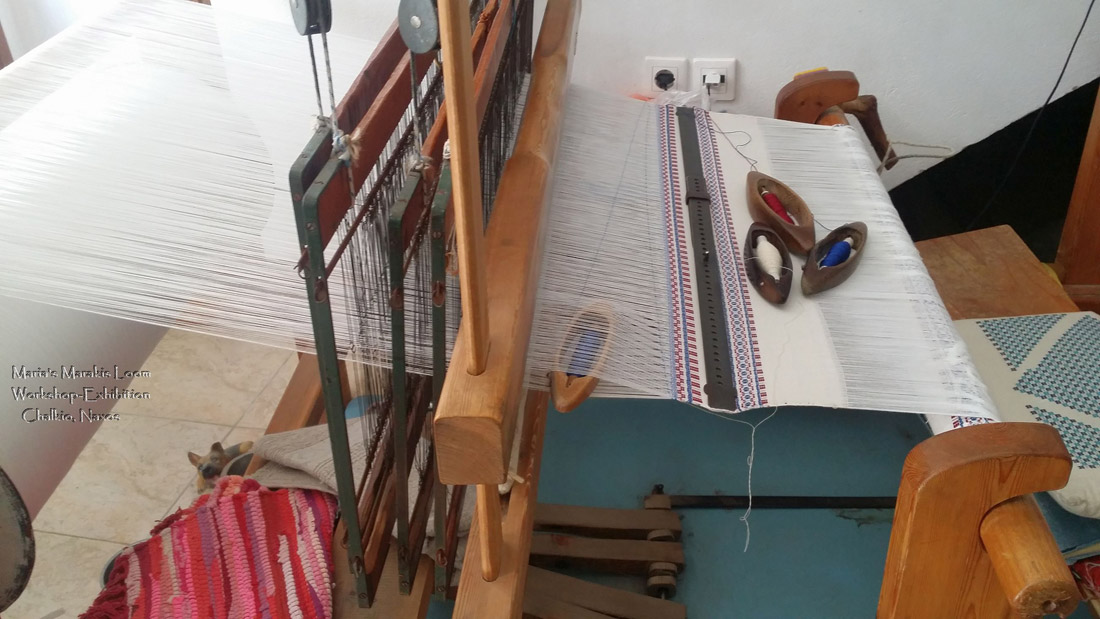
Working on a loom is a demanding and difficult task. You need to be calm to weave properly on the loom. Both mind and body must be focused on it. It requires continual counting when working, while the moves required are physically demanding for the entire body. There’s no way that you can work for more than eight hours. The proper use of throwing the shuttle, calculating the correct yardage, setting a tenterhook and maintaining an even beat needs great attention and focus as well as the proper finishing of the woven piece. You have to know how to use different fibers and colors in one project, and a range of finishing techniques with trims and fringes. Textiles are made with different patterns, colors, textures and densities for all different purposes. All these are time consuming and they need great patience and love for it. The most important thing is that if a thread is broken or missing, weaving is not possible with the Loom.
But it’s a magical feeling to be making something completely new on an old loom, Mrs. Maria Maraki explained – one of the oldest women from Moni village, an incredibly talented weaver, very knowledgeable in the subject that continues the loom tradition since 1960. She has been a teacher to the new generations for keeping this tradition going on over the years and she has created the Weavers Association of Women of Moni and she is the president of the Association. She maintains also her own Exhibition-Workshop in Chalkio village, Naxos, with a great variety and a wonderful selection of these unique artifacts and accessories. She says: “my reward is the thousands of tourists that pass by every day and buy my creations, and my work travels around the globe. My textiles of contemporary styles of this uniqueness, sophistication and quality travel from Alaska to South Africa and from Europe to New Zealand, and I am very proud because my creations travel the world.” For her, weaving is not just a skill; it is a ritual of love for the art itself, admiration towards the beauty of the handmade artifacts with tenacity that comes from the heart.
She started her loom journey at the age of 15 when she learned how to weave. Later, her passion was to teach the women of her village and the adjacent villages to learn the technique, help them grow and embrace new skills. Hand-loom textiles need constant innovation, new designs and styles and Maria Maraki with her long experience and skills is a master on that, able to create astonishing pieces with intricate designs and embroidery; all adapted to the modern tastes and perceptions as well.
ELaiolithos offers unique shopping experience to its guests with visits to Chalkio and the Exhibition – Art of the Loom Gallery and Shop of Maria Maraki or her daughter’s Anastasia Maraki shop named “Nature and Art” where a stunning and extensive collection of these handmade artifacts can be seen. Handbags, wallets, place mats, tablecloths, curtains, runners, coasters, towels, centerpieces, scarves, pillow cases, bracelets, sofa throws, and many more….whatever a house needs to be decorated and adorned either for every day or for special occasions. One-of-a-kind pieces with unique patterns in different colors and artistic designs – all created by fantasy and talent. There is no way you would not find something to delight you, and you can choose the piece you like and matches your style and preference from their shops. Treat yourself to one of a kind local textile to accent your house decor, and to remember your trip to Naxos, Greece or find the perfect gift for your loved ones!
Looking at traditional textiles throughout the world is also a way to aesthetically define culture, geography, and social structure. Here with this article I try to give you an idea about the multitude of the weaving tradition in Naxos. Weaving connects people through time and within the community. There is not an art so central, and so fully shared among the people, as the loom woven textile art. The exquisite and complex motifs of these creations have been around for thousands of years, and their power and longevity contribute substantially to the Naxian culture.
Weaving is about living in harmony with the earth because it is a man made art created from the elements available in the steppe landscape. It is an amazing craft art which utilizes beautiful wooden tools: looms, shuttles, frames and more. These tools are works of art in themselves, and of themselves. From table clothes to runners, aprons to rugs, wedding veils to curtains, and hand towels to yoga blankets, shawls, sofa throws and place-mats, textiles surround us, continue to be in our everyday life just like housing, food, and water, and accentuate our personal spaces distinctly.
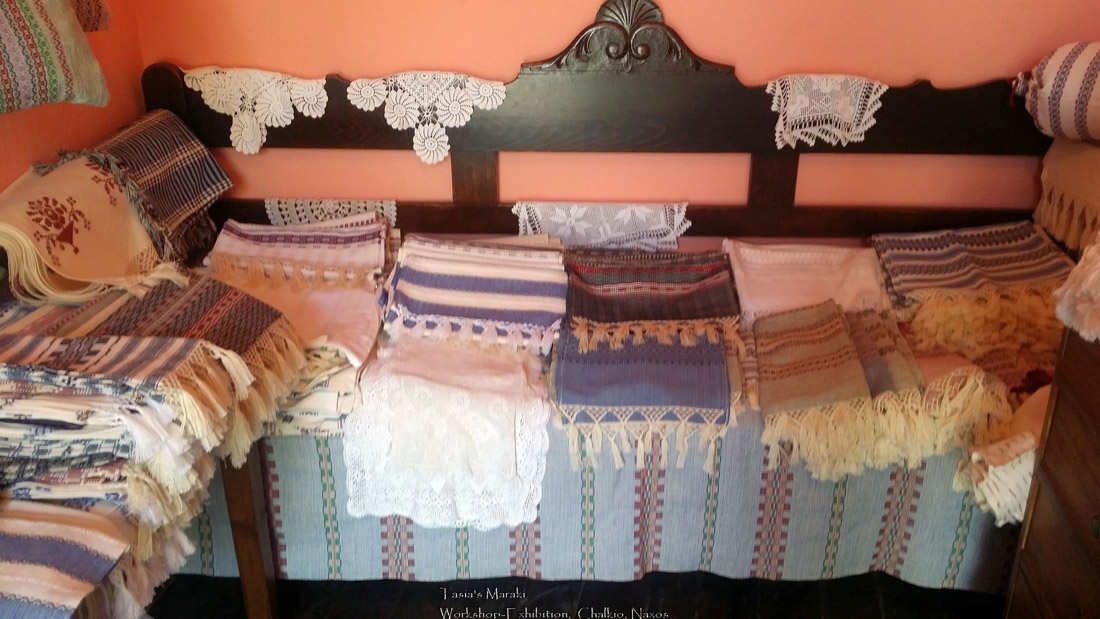
In Plato’s Republic, the three Fates (Moirae) are the female personifications of human destiny, each playing a different role in the weaving of the fabric of life:
- Clotho spins the thread of life from her distaff onto her spindle,
- Lachesis measures the length of the thread of life with her rod, and
- Atropos is the cutter of that thread, determining life’s end.
This art is at risk of disappearing in the shadow of urbanization and importation of cheaper commodities. That’s a reason why all of us must value and support the loom weaving craft tradition. It serves as a connection between generations, where these women are in reality artists of the loom weaving, which step on an old tradition and come up with their own interpretation of the past.
Traveling to Naxos is a joy. Naxos is rustic, historic, and full of intrigue. What more could you want from a place? Buying a loom weaving textile is something worth bringing home & something worth supporting….because these hand-made artistic creations not only romanticize the pre-industrial life, they also offer in a way, a return to our childhood.
Why buying these artifacts?
- Hand-woven loom artifacts have an invisible stamp of uniqueness and authenticity
- They are functional. They are usually designed with an end user in mind, who would put an object to a test by wearing it or carrying it, storing things on it, touching it. It can be put on display for others to admire, but unlike a piece of fine art, it will have an aesthetic as well as utilitarian value.
- They are locally produced items. That means they have a smaller carbon footprint in terms of transportation and, in general, it’s good to know where the items you surround yourself with are coming from.
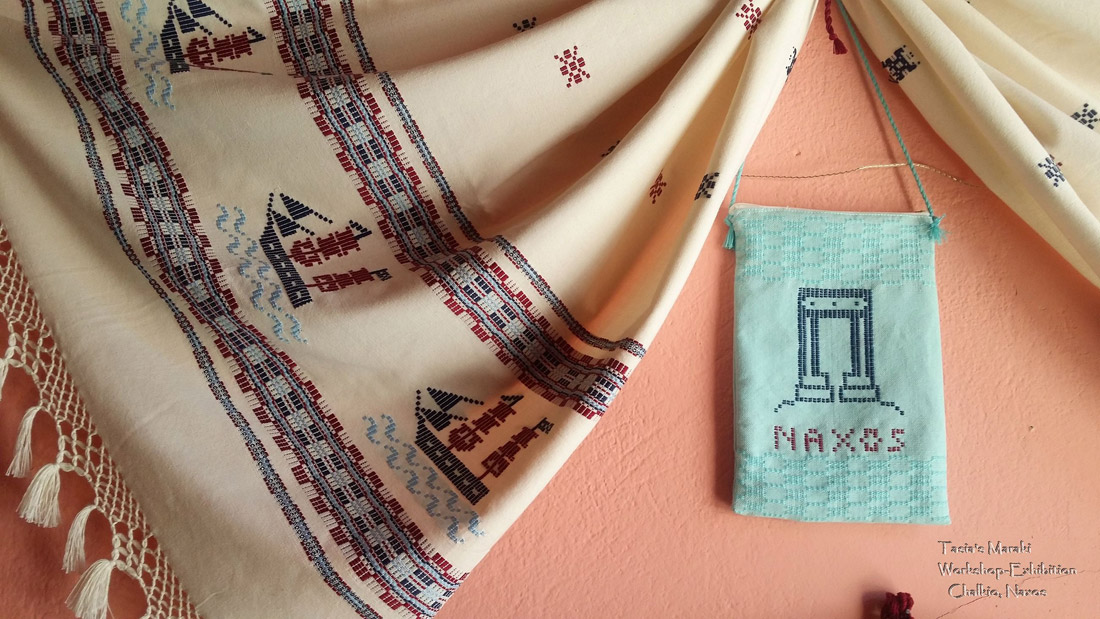
ELaiolithos also offers loom weaving classes for those who show an interest in the art. You can contact us for further details on the subject. Discover local eco-arts and crafts on your holiday travel..… Hand-woven, beautiful, artful and sustainable…..
Article written by Copyright © Helen Marakis . All rights reserved







